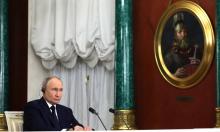The Russian ruble: The coin with a scar
The Russian currency is nearly seven centuries old. It appeared in the 13th century and for the next two centuries successfully drove out of circulation coins of other countries that people in ancient Russia used to acquire material goods. In addition, the foreign money made of silver was quickly repurposed into the new Russian ruble. The name was given to the currency because of the scar that emerged during the coin production. The ruble was made according to the ancient method where the coin was poured into a mold in two steps.
The progenitor of the modern ruble did not have a neat appearance, and had an ugly scar on the edge. Previously, there was another theory of the origin of the term "ruble." They say that the hryvna, the former currency in circulation in Russia, was allegedly severed into pieces to obtain change. The verb "sever" ("rubit'" in Russian) gave the name to the new monetary unit. However, this theory has failed when historians found that both the ruble and hryvna in ancient times were of the same weight - 200 grams.
The popularity of the new coins quickly gained momentum, which is not surprising given that earlier in Russia skins of fur-bearing animals - squirrels, foxes and martens - were used as currency along with foreign coins that eventually were replaced with featureless silver bullion - the hryvna. Hryvna was convenient as a currency because at that time Russia was divided into separate kingdoms, each of them lived its own life. It was with hryvna that the ruble, the first mention of which appeared in the Novgorod birch bark documents in 1281-1299, had to struggle with.
For a long time, the monetary unit was used equally in Kiev Rus. The approach to the ruble from the start was creative. These coins, although had the same name, looked differently in all the principalities, depending on the preferences and fantasies of the ruling prince. Only in the Moscow principality the coins were similar to those of Novgorod. Coins were minted in silver and copper. The wire was struck with a chisel to flatten it, then a coin would be cut off. One can imagine how ugly the forefathers of the modern Russian ruble looked. However, their appearance was saved by the original image that the artisans in Russia took great care of. The old coins depict warriors with axes and swords, roosters, leopards, riders with falcons or even men in broad-brimmed hats.
The standoff between the ruble and the hryvna ended with the victory of the latter in 1534 under the rule of Elena Glinsky, the mother of Ivan the Terrible. It was then that the ruble acquired the status of the single monetary currency of the entire Russian state, which remains to this day. A century later, during the reign of Tsar Alexei Mikhailovich, the coins first displayed the word "ruble". At the time, only Moscow mint house was engaged in the production of coins, and the ruble began acquiring its characteristic features. For example, the face of the coin displayed a two-headed eagle, and the reverse side displayed the tsar on top of a horse.
With the loss of individuality the ruble coins lost their value. Under Tsar Aleksey Mikhailovich the actual value of the ruble was 64 silver kopecks. In 1656, in order to save money, the coins were minted exclusively of copper. This experiment ended with a riot called "The Bronze rebellion" that was suppressed through bloodshed. A year later, copper coins were devalued and removed from circulation.
Emperor Peter I was smarter than his father, and began to produce rubles that were 100 percent silver. Along with those, ostensibly for the convenience of the people in the trade, he introduced copper and silver coins. The issuance of this money had a positively effect on the treasury.
The paper ruble appeared in 1769, during the reign of Catherine the 2nd, who, being a frugal ruler, was saving money for a war with Turkey and dramatically reduced the production of silver coins. The worst year for the single currency of Russia was 1915. Then, the ruble was printed only on paper and depreciated catastrophically, which, however, did not prevent it from surviving the collapse of the Russian Empire and stepping into the "bright socialist future."
Incidentally, the USSR in 1923 issued rubles minted from gold. It did not last long, and most of them have been spent on payments to other states. The last Soviet rubles with a new design were released in 1991, and a year later the ruble continued its story in a completely different country - the Russian Federation, where it survived a denomination in 1998, and met the new millennium in its updated form.
Looking at the history of the survival of the ruble that has recently been increasingly devalued, one would want to believe that it deserves the status of the reserve currency, at least at the regional level. Unfortunately, at this moment, the ruble does not even have an official symbol. The Bank of Russia is to blame since it has not yet selected the winner of the contest "Ruble Mark", held back in 2006.
In this difficult situation, the ruble received support from the people who created a mark informally used in RuNet and called "Tarbeev - Lebedev mark." The symbol of the ruble is the capital letter "R", crossed below the semicircle. Maybe the adoption of the new mark will end the crisis and the ruble turns into the ancient and courageous "coin with a scar."
Maria Snytkova.
Subscribe to Pravda.Ru Telegram channel, Facebook, RSS!





